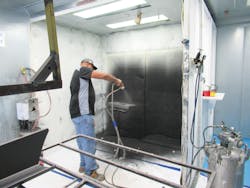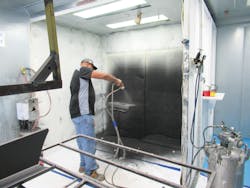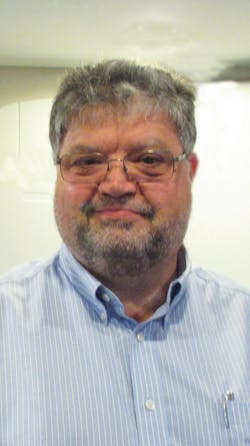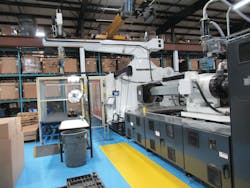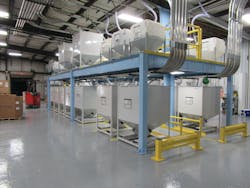But Mack Molding’s Southern division, which consists of plants in Statesville, N.C., and Inman, S.C., has turned its painting capabilities into a competitive advantage. Together, the plants have five paint lines.
“We want to vertically integrate as many of those operations as possible,” said Bryan Campbell, president of Mack Molding’s Southern division. “That is a huge differentiator for us. Our customers can come to us to mold it, move it down the hallway to paint it, assemble it and add componentry, preferably all under one roof. The more we can do for our customers, the better it is for them.”
The Statesville plant has 10 paint booths within a clean-room system, as well as a curing oven. All painting is done manually; however, a conveyor system moves parts in and out of all 10 booths. The conveyor system was designed in-house.
During PMM’s visit, one part being painted could be painted multiple colors. Each painting booth has equipment that can be programmed to quickly change colors in order to provide the correct paint for each sequence of parts.
“Our customers want to buy more than a plastic part,” Carinci said. “They want to buy a component, so they don’t have to build that labor cost into their facilities.”
Complementary FACILITIEs
While injection molding is at the core of Mack Molding’s operations in the Carolinas, company officials always refer to themselves as contract manufacturers.
The two Carolina plants are structured to complement each other. The Statesville plant specializes in small to medium-sized parts while the Inman plant primarily molds larger parts.
The Statesville plant is in the midst of a significant expansion, growing from its current 125,000 square feet to 200,000 square feet by the end of this year. The addition includes about 25,000 square feet of manufacturing space and 50,000 square feet for warehouse, recycling and packaging operations. It’s also recently added new painting capacity.
Mack Molding acquired the Statesville plant in 1990 when it purchased Fame Plastics. At that time, the plant focused on structural foam molding for companies such as IBM. Since then, sales of products made in Statesville have increased fourfold as new processes, such as gas-assist, have been added.
“We do gas-assist, structural foam, overmolding and straight injection molding,” Carinci said. “If a process is used in the injection molding business, we have probably touched it.”
Carinci said the plant currently manages more than 500 production molds and performs an average of 10 mold changes per day.
“We are in the medium-volume business,” Carinci said. “We do not have a lot of high-volume work. Medium is our niche.”
Heavy truck parts are a major focus for the Statesville plant. Other parts serve the security, oil and energy, and lawn and garden industries; the company also makes parts for side-by-side recreational vehicles and other industrial/commercial parts. Mack does not do Tier 1 automotive parts molding. However, both of Mack’s Southern division plants are IATF 16949-certified for supplying truck manufacturers.
Moving to all-electric
The Statesville plant has 24 molding machines with clamping forces ranging from 78 tons to 1,300 tons. Toshiba presses were a mainstay of the plant for many years, but a switch to Milacron machines is taking place, primarily because of the need to update and the energy efficiency of newer all-electric and servo-hydraulic machines.
A total of 10 presses are now Milacrons, including five Roboshot models. All the presses smaller than 300 tons are electric.
The recent Milacron acquisitions include a 1,300-ton Maxima servo-hydraulic press and a 500-ton Magna T servo toggle.
The 1,300-ton Maxima, coupled with a Cartesian robot from HyRobotics, is currently molding the front panel for a pump housing for the energy/fuel market. Carinci said the machine will probably be the largest the facility acquires. Before the plant brought it online, Statesville’s largest press had 1,100 tons of clamping force.
Statesville plant officials are anticipating the expansion to accommodate six more molding machines for a total of 30. The Inman plant has presses ranging from 500 tons of clamping force to 4,000 tons.
“We try not to cross paths too much,” Carinci, Statesville’s manager, said. “We will mold small parts and ship them to Inman so they can build them into larger assemblies. There are some parts Inman builds and ships here to Statesville so we can build them into assemblies.”
Mack Molding tends to write general specifications when shopping for new injection presses. “Our specifications tend to be more general because our applications are much more general than specific,” Campbell said. “We cannot buy a machine to produce just one part because it is going to see 50 or more applications. So, we try to buy to general specifications.”
Campbell used core pulls as an example. “We generally say we want two on the front and two on the back and four moving actions, even though only 10 molds out of 50 going in that machine will require that. We need to have that capability and availability so we have flexibility.”
Drying equipment in the plant is primarily from Matsui. “We like their equipment for the rotary desiccant beds and quick drying time,” Carinci said. “We are very diversified in this plant and change tools often. We want a quick return on drying time, and that has always been a forte of the Matsuis.
“We also have a good record of repair with them. The desiccant rotors last a long time, and, when they go bad, we put a new one in and they keep running,” he said.
Delta T Systems supplied the plant’s cooling equipment. Recently, the Statesville plant added its first high-temperature-control units that handle water as hot as 300 degrees Fahrenheit. Some newer engineering-grade materials need higher temperatures to achieve the best surface finish.
Blenders throughout the Statesville plant are from Maguire.
Robots come from three different suppliers. Star Automation Inc. supplied most robots in the past, but recent purchases have been six-axis robots from Kuka Robotics and Cartesian robots from HyRobotics. Campbell said both Southern division plants are now primarily buying HyRobotics products.
The plant has no collaborative robots. “With our diversification and low-to-medium-volume niche, cobots don’t yet seem to have a return. Also, there are payload challenges for some of our heavier parts,” Campbell said.
A unique feature of the Statesville plant is a materials-conveying system built in-house that was finished about two months ago. The plantwide system allows a technician to load resin into a bin that is designated for a molding machine. The resin is then transported through vacuum conveyance pipes to a dryer at that machine. Dryer settings are managed at each machine.
“We took some existing pumps and built them into a new system,” Campbell said. “We added a couple more pumps to increase capacity. For the most part, we did it ourselves with the help of a general contractor, RPM Plastics of Statesville. The design and concept was all Mack Molding. RPM assisted in the equipment specifications and install.”
The company built a mezzanine to hold all 30 tapered bins.
Carinci said that since labor is utilized more efficiently with the new system, the person who used to spend a lot of time running back and forth to the resin boxes is now able to prepare for the next job or get the next material to a pre-dry station.
“The tricky part is to make sure you have everything well-identified and to make sure the people who are transferring material into the vacuum system are making sure the identity of material is solid and that, as you move from place to place, you have everything in the right position,” Carinci said.
“There is a little bit of training, education and discipline involved in the management of it,” he said.
The plant has 300 employees and operates 24 hours a day, six days a week. Sundays are not a regular production day, though they are used occasionally.
Scientific molding is a core principle of the operation. Five RJG-certified master molders are on staff with another employee in the process of gaining certification. Every technician has been through systematic molding training. RJG has conducted classes in Statesville, and the company has sent employees to the Polymers Center of Excellence in Charlotte, N.C.
Quality-control auditors roam the production floor on all shifts, checking both parts and processes. A second audit process makes sure no bad parts get out of the building. Parts leave the building in perfectly sized boxes that are assembled in the plant with a Swiss-made box machine.
Making the decision to replace
Campbell said production data such as machine capacity, yield and scrap is reviewed quarterly and can help determine when an injection molding machine needs to be replaced.
Though the company has recently purchased Milacrons, he said it considers other suppliers every time it chooses a new press. “We want to be intelligent purchasers and make sure they stay competitive. It is not a given that we will go to one manufacturer. But we want to stay in an environment where the technology is solid,” Campbell said.
Carinci said that as a rule of thumb, a machine that is 20 years old is evaluated for replacement. “We also have qualifiers as to how many hours it has run and shots it has put out,” he said.
“Parts availability is another criterion we use to determine if we need to replace a piece of equipment,” Carinci said. “We may have a problem getting parts for a machine that has been in the plant for 15 to 20 years. You have to keep in mind that if a controller goes down and there are no parts to repair it, that becomes a big issue.”
Carinci said the plant’s business model is built around flexibility. “We need to be as flexible as we can be to serve our customers’ needs. We are diversified, we can move from one job to another and we can change on a whim,” he said. “If a customer has an inventory shortage or something that they need supplied quickly, that is what we pride ourselves in doing.
“That principle also determines how and when we buy primary equipment, what to buy, what not to buy, when to buy it,” he said. “We like to have extra capacity to handle the changing needs of our customers.”
Ron Shinn, editor
Contact:
Mack Molding Statesville Statesville, N.C., 704-878-9641
About the Author
Ron Shinn
Editor
Editor Ron Shinn is a co-founder of Plastics Machinery & Manufacturing and has been covering the plastics industry for more than 35 years. He leads the editorial team, directs coverage and sets the editorial calendar. He also writes features, including the Talking Points column and On the Factory Floor, and covers recycling and sustainability for PMM and Plastics Recycling.
